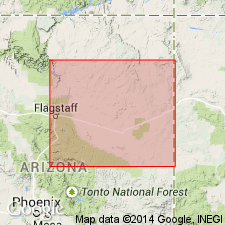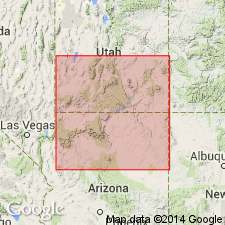
- Usage in publication:
-
- Wupatki member*
- Modifications:
-
- Original reference
- AAPG geologic province:
-
- Plateau sedimentary province
- Black Mesa basin
Summary:
Pg. 86, 87 (fig. 1). Wupatki member of Moenkopi formation. Red beds (shaly siltstones and structureless mudstones) alternating with resistant thick-bedded sandstones. Thickness over 50 feet. Underlies Winslow member (new); overlies Kaibab limestone. [Age is Early Triassic.]
Named in Winslow-Holbrook area, [Navajo Co.], northeastern AZ. [Probably named from Wupatki National Monument, Coconino Co., northeastern AZ.]
Source: US geologic names lexicon (USGS Bull. 1200, p. 4307-4308); supplemental information from GNU records (USGS DDS-6; Denver GNULEX).

- Usage in publication:
-
- Wupatki member
- Modifications:
-
- Areal extent
- Dominant lithology:
-
- Sandstone
- Siltstone
- Claystone
- Mudstone
- Conglomerate
- Limestone
- AAPG geologic province:
-
- Plateau sedimentary province
Summary:
Pg. 18, 19. Wupatki member of Moenkopi formation. Thickness ranges from 70 to 119 feet. Underlies Moqui member (new) in Poverty Tank-Concho area, northeastern AZ. Units here called Wupatki and Moqui were referred to as Salt Creek by Hager (1922, Mining and Oil Bull., v. 8, no. 2, p. 73). [Age is Early Triassic.]
Source: US geologic names lexicon (USGS Bull. 1200, p. 4307-4308).
For more information, please contact Nancy Stamm, Geologic Names Committee Secretary.
Asterisk (*) indicates published by U.S. Geological Survey authors.
"No current usage" (†) implies that a name has been abandoned or has fallen into disuse. Former usage and, if known, replacement name given in parentheses ( ).
Slash (/) indicates name conflicts with nomenclatural guidelines (CSN, 1933; ACSN, 1961, 1970; NACSN, 1983, 2005, 2021). May be explained within brackets ([ ]).

